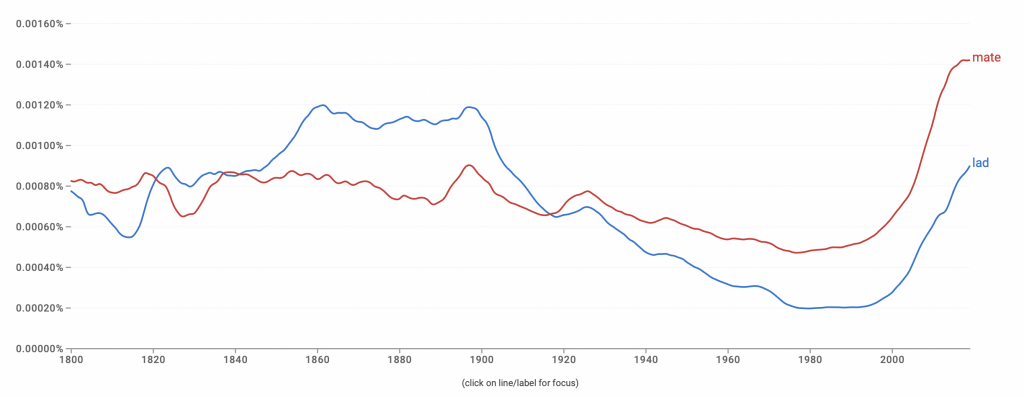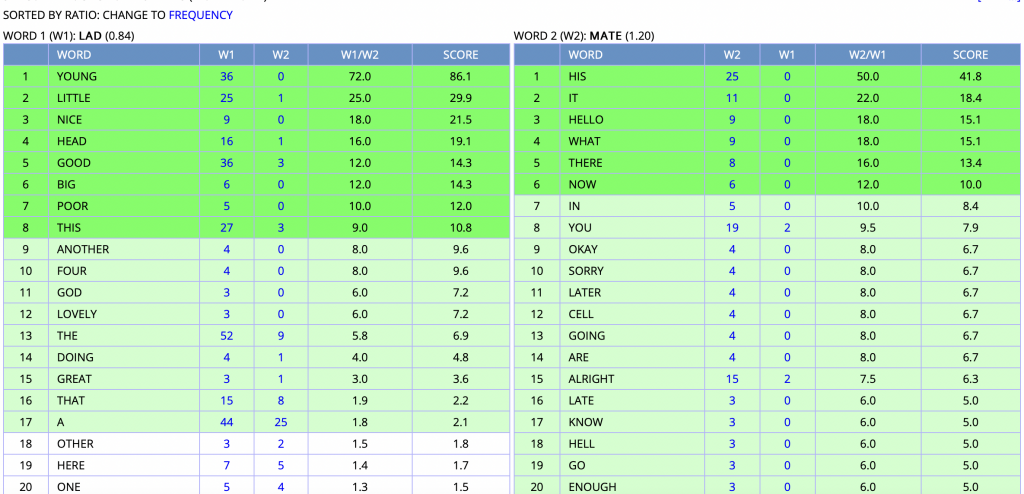British Slang: Lad vs. Mate
When you talk to a British person, you’ll probably notice rather quickly that they commonly use terms such as lad and mate to refer to other people. If you’re interested in learning more about these terms and what distinguishes them, come along on this linguistic journey with me!
Is the Usage of the two Terms lad and mate an Exclusively British Phenomenon?
If we take a look at the entries of lad and mate in the corpus of Global Web-based English (GloWbE) (Davies, 2013) (Figure 1), it shows us that using mate and lad is not an exclusively British phenomenon. It’s also commonly used in other countries such as Australia. Generally, mate is used more commonly than lad.
Figure 1
Frequency of Usage of the Words lad and mate in different countries according to GloWbE (Davies, 2013)


Why one is Used More Frequently by the Brits?
The n-gram of the two words below reveals that mate is more common than lad in general terms.
Figure 2
N-Gram indicative of the frequency of usage of the words lad and mate

However if we take a look at both terms, lad and mate, in the British National Corpus (BNC), we will find that both terms are used approximately equally often. While lad has a raw frequency of use of 1,840, mate has one of 1,785 (Davies, 2004). This discrepancy to the google n-gram might be due to different reasons, one of them being that the n-gram is not specifically tailored to Great Britain.
In Which Contexts are They Used?
Take a look at the following charts:
Figure 3
Usage frequency of the word lad divided by sections in the BNC (Davies, 2004)

Figure 4
Usage frequency of the word mate divided by sections in the BNC (Davies, 2004)

As we can see in Figures 3 and 4, both words, lad as well as mate, are primarily used in spoken language. What’s interesting now is that mate, with regard to spoken language, which is what primarily interests us here, is in fact more frequently used than lad. Additionally, the word lad seems to play a bigger role in fiction.
What’s the Difference Between lad and mate?
At this point you might be wondering what the actual difference between both words is. While both words are generally used to refer to or address someone, there are some nuanced differences. By looking at some collocates of the words in the BNC (Figure 5), we can find out more. In this case we’re particularly interested in which words commonly precede the words lad and mate since adjectives as well as greetings usually precede the noun.
Figure 5
Comparison of collocates of the words mate and lad in the BNC (Davies, 2004)

Figure 5 shows us that while mate is often times used to directly address someone as in sentences such as Hello mate. or Sorry mate., lad is rather used in the context of talking about another person, i.e. the lad, in conversation with other people and less as a direct means of addressing said person. Also, as collocates such as young lad or little lad indicate, the word lad is most frequently used to refer to a younger person while mate is more universally applicable.
Takeaway Message
Now you not only learned some cool fun facts about British slang but you can engage in conversation with Brits even more authentically as you won’t mix up the two words since you know what they are differentiated by. 😉
References:
Davies, M. (2004) British National Corpus (from Oxford University Press). https://www.english-corpora.org/bnc/
Davies, M. (2013) Corpus of Global Web-Based English: 1.9 billion words from speakers in 20 countries (GloWbE). https://english-corpora.org/glowbe/
lad and mate (n.d.). In Google Books N-Gram Viewer. retrieved January 21st, 2024 from https://books.google.com/ngrams/graph?content=lad%2C+mate&year_start=1800&year_end=2019&corpus=en-2019&smoothing=3